MBA 712: Economic Impact of Online Shopping Tax in Australia.
VerifiedAdded on 2023/05/28
|10
|2659
|162
Case Study
AI Summary
This case study examines the implications of Australia's online shopping tax, introduced to collect tax on imports under $1000 at a rate of 10% GST. The tax aims to increase government revenue for public services but has significant consequences for both consumers and retailers. For consumers, the tax increases the price of goods and services, making Australian online sites less competitive compared to overseas sites like Amazon. Retailers face disadvantages due to higher operating costs, leading to reduced competitiveness. The study also explores how online shopping platforms affect economic surplus, with the tax potentially lowering both consumer and producer surplus. The long-term impact on Australian domestic retailers is discussed, considering potential shifts in consumer behavior to evade the tax through VPNs and freight forwarding services.
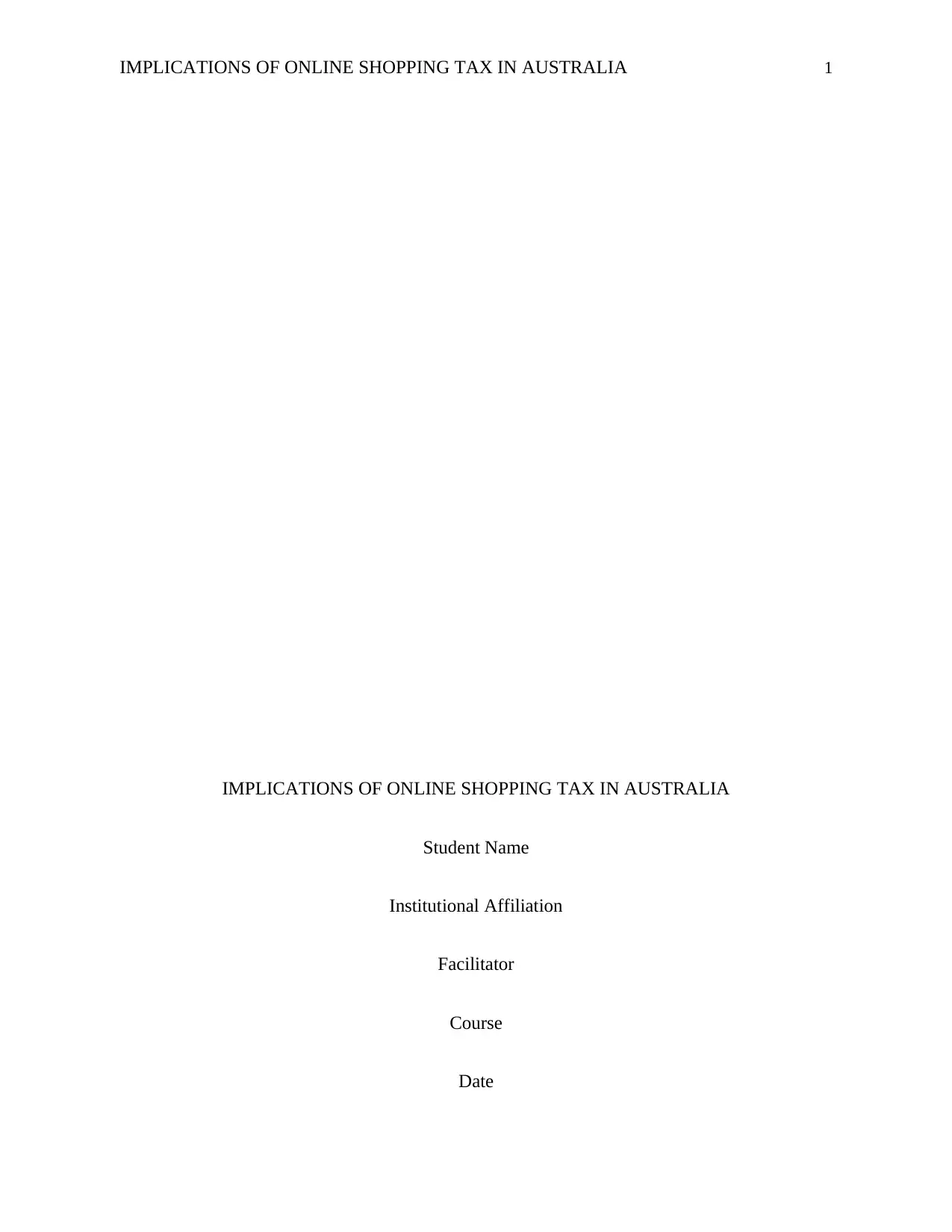
IMPLICATIONS OF ONLINE SHOPPING TAX IN AUSTRALIA 1
IMPLICATIONS OF ONLINE SHOPPING TAX IN AUSTRALIA
Student Name
Institutional Affiliation
Facilitator
Course
Date
IMPLICATIONS OF ONLINE SHOPPING TAX IN AUSTRALIA
Student Name
Institutional Affiliation
Facilitator
Course
Date
Paraphrase This Document
Need a fresh take? Get an instant paraphrase of this document with our AI Paraphraser
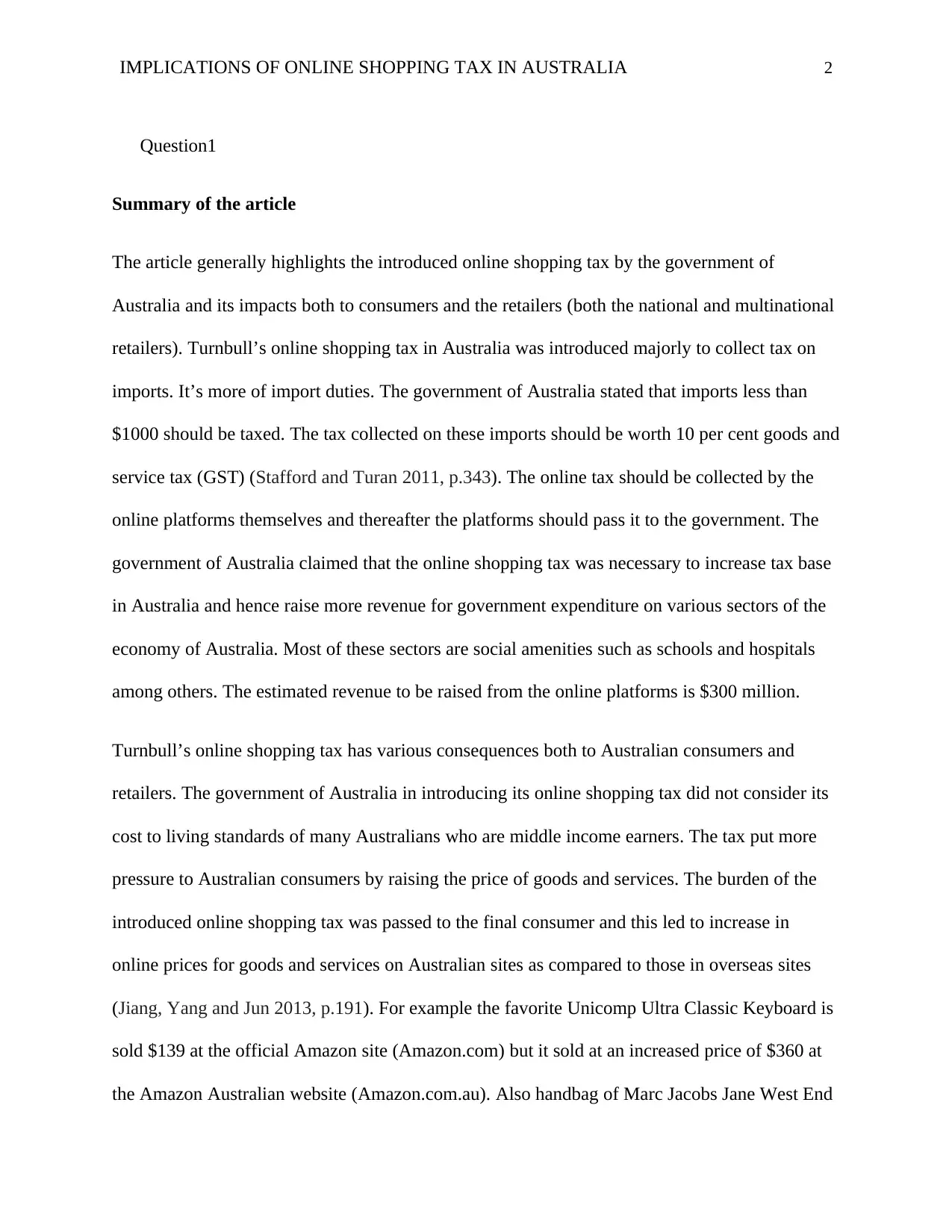
IMPLICATIONS OF ONLINE SHOPPING TAX IN AUSTRALIA 2
Question1
Summary of the article
The article generally highlights the introduced online shopping tax by the government of
Australia and its impacts both to consumers and the retailers (both the national and multinational
retailers). Turnbull’s online shopping tax in Australia was introduced majorly to collect tax on
imports. It’s more of import duties. The government of Australia stated that imports less than
$1000 should be taxed. The tax collected on these imports should be worth 10 per cent goods and
service tax (GST) (Stafford and Turan 2011, p.343). The online tax should be collected by the
online platforms themselves and thereafter the platforms should pass it to the government. The
government of Australia claimed that the online shopping tax was necessary to increase tax base
in Australia and hence raise more revenue for government expenditure on various sectors of the
economy of Australia. Most of these sectors are social amenities such as schools and hospitals
among others. The estimated revenue to be raised from the online platforms is $300 million.
Turnbull’s online shopping tax has various consequences both to Australian consumers and
retailers. The government of Australia in introducing its online shopping tax did not consider its
cost to living standards of many Australians who are middle income earners. The tax put more
pressure to Australian consumers by raising the price of goods and services. The burden of the
introduced online shopping tax was passed to the final consumer and this led to increase in
online prices for goods and services on Australian sites as compared to those in overseas sites
(Jiang, Yang and Jun 2013, p.191). For example the favorite Unicomp Ultra Classic Keyboard is
sold $139 at the official Amazon site (Amazon.com) but it sold at an increased price of $360 at
the Amazon Australian website (Amazon.com.au). Also handbag of Marc Jacobs Jane West End
Question1
Summary of the article
The article generally highlights the introduced online shopping tax by the government of
Australia and its impacts both to consumers and the retailers (both the national and multinational
retailers). Turnbull’s online shopping tax in Australia was introduced majorly to collect tax on
imports. It’s more of import duties. The government of Australia stated that imports less than
$1000 should be taxed. The tax collected on these imports should be worth 10 per cent goods and
service tax (GST) (Stafford and Turan 2011, p.343). The online tax should be collected by the
online platforms themselves and thereafter the platforms should pass it to the government. The
government of Australia claimed that the online shopping tax was necessary to increase tax base
in Australia and hence raise more revenue for government expenditure on various sectors of the
economy of Australia. Most of these sectors are social amenities such as schools and hospitals
among others. The estimated revenue to be raised from the online platforms is $300 million.
Turnbull’s online shopping tax has various consequences both to Australian consumers and
retailers. The government of Australia in introducing its online shopping tax did not consider its
cost to living standards of many Australians who are middle income earners. The tax put more
pressure to Australian consumers by raising the price of goods and services. The burden of the
introduced online shopping tax was passed to the final consumer and this led to increase in
online prices for goods and services on Australian sites as compared to those in overseas sites
(Jiang, Yang and Jun 2013, p.191). For example the favorite Unicomp Ultra Classic Keyboard is
sold $139 at the official Amazon site (Amazon.com) but it sold at an increased price of $360 at
the Amazon Australian website (Amazon.com.au). Also handbag of Marc Jacobs Jane West End
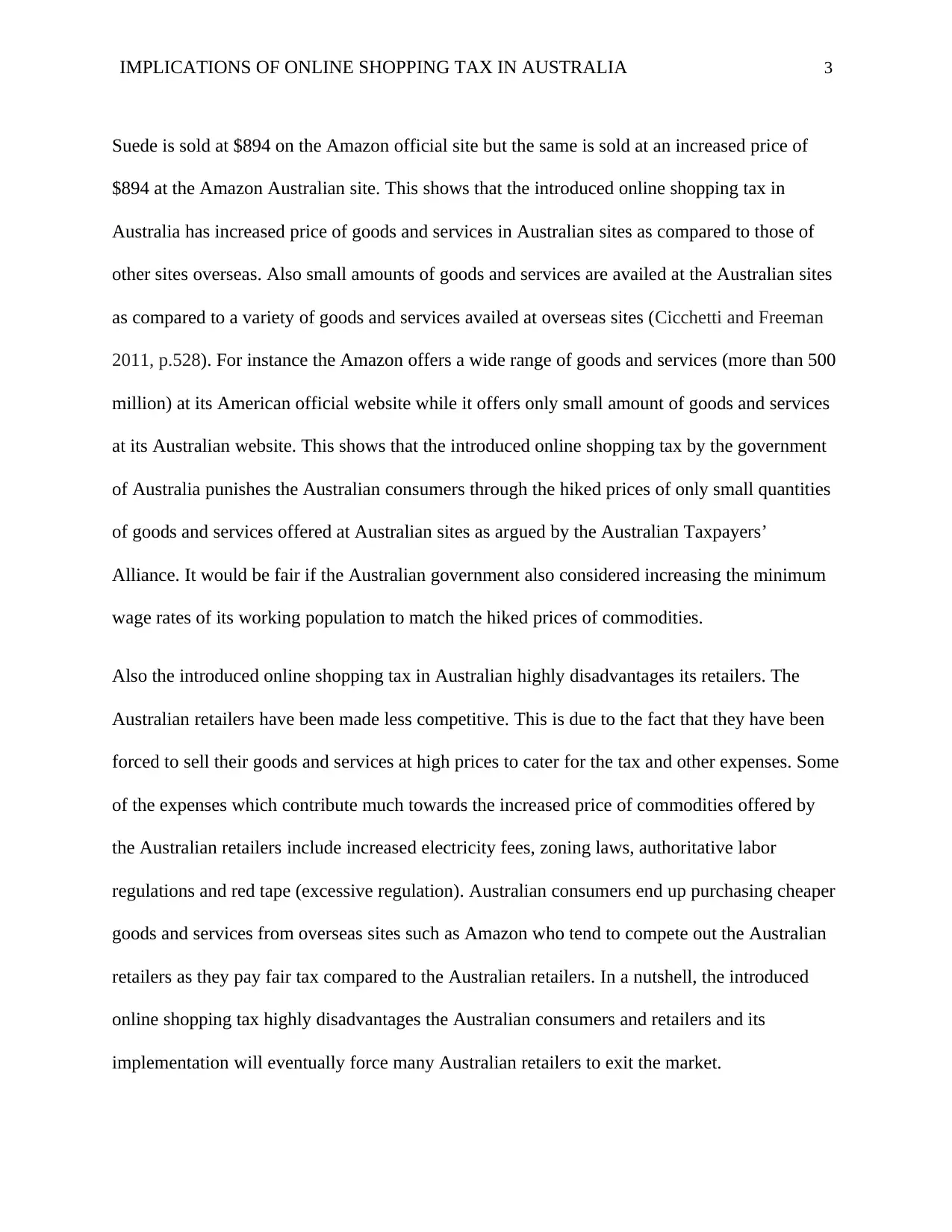
IMPLICATIONS OF ONLINE SHOPPING TAX IN AUSTRALIA 3
Suede is sold at $894 on the Amazon official site but the same is sold at an increased price of
$894 at the Amazon Australian site. This shows that the introduced online shopping tax in
Australia has increased price of goods and services in Australian sites as compared to those of
other sites overseas. Also small amounts of goods and services are availed at the Australian sites
as compared to a variety of goods and services availed at overseas sites (Cicchetti and Freeman
2011, p.528). For instance the Amazon offers a wide range of goods and services (more than 500
million) at its American official website while it offers only small amount of goods and services
at its Australian website. This shows that the introduced online shopping tax by the government
of Australia punishes the Australian consumers through the hiked prices of only small quantities
of goods and services offered at Australian sites as argued by the Australian Taxpayers’
Alliance. It would be fair if the Australian government also considered increasing the minimum
wage rates of its working population to match the hiked prices of commodities.
Also the introduced online shopping tax in Australian highly disadvantages its retailers. The
Australian retailers have been made less competitive. This is due to the fact that they have been
forced to sell their goods and services at high prices to cater for the tax and other expenses. Some
of the expenses which contribute much towards the increased price of commodities offered by
the Australian retailers include increased electricity fees, zoning laws, authoritative labor
regulations and red tape (excessive regulation). Australian consumers end up purchasing cheaper
goods and services from overseas sites such as Amazon who tend to compete out the Australian
retailers as they pay fair tax compared to the Australian retailers. In a nutshell, the introduced
online shopping tax highly disadvantages the Australian consumers and retailers and its
implementation will eventually force many Australian retailers to exit the market.
Suede is sold at $894 on the Amazon official site but the same is sold at an increased price of
$894 at the Amazon Australian site. This shows that the introduced online shopping tax in
Australia has increased price of goods and services in Australian sites as compared to those of
other sites overseas. Also small amounts of goods and services are availed at the Australian sites
as compared to a variety of goods and services availed at overseas sites (Cicchetti and Freeman
2011, p.528). For instance the Amazon offers a wide range of goods and services (more than 500
million) at its American official website while it offers only small amount of goods and services
at its Australian website. This shows that the introduced online shopping tax by the government
of Australia punishes the Australian consumers through the hiked prices of only small quantities
of goods and services offered at Australian sites as argued by the Australian Taxpayers’
Alliance. It would be fair if the Australian government also considered increasing the minimum
wage rates of its working population to match the hiked prices of commodities.
Also the introduced online shopping tax in Australian highly disadvantages its retailers. The
Australian retailers have been made less competitive. This is due to the fact that they have been
forced to sell their goods and services at high prices to cater for the tax and other expenses. Some
of the expenses which contribute much towards the increased price of commodities offered by
the Australian retailers include increased electricity fees, zoning laws, authoritative labor
regulations and red tape (excessive regulation). Australian consumers end up purchasing cheaper
goods and services from overseas sites such as Amazon who tend to compete out the Australian
retailers as they pay fair tax compared to the Australian retailers. In a nutshell, the introduced
online shopping tax highly disadvantages the Australian consumers and retailers and its
implementation will eventually force many Australian retailers to exit the market.
⊘ This is a preview!⊘
Do you want full access?
Subscribe today to unlock all pages.

Trusted by 1+ million students worldwide
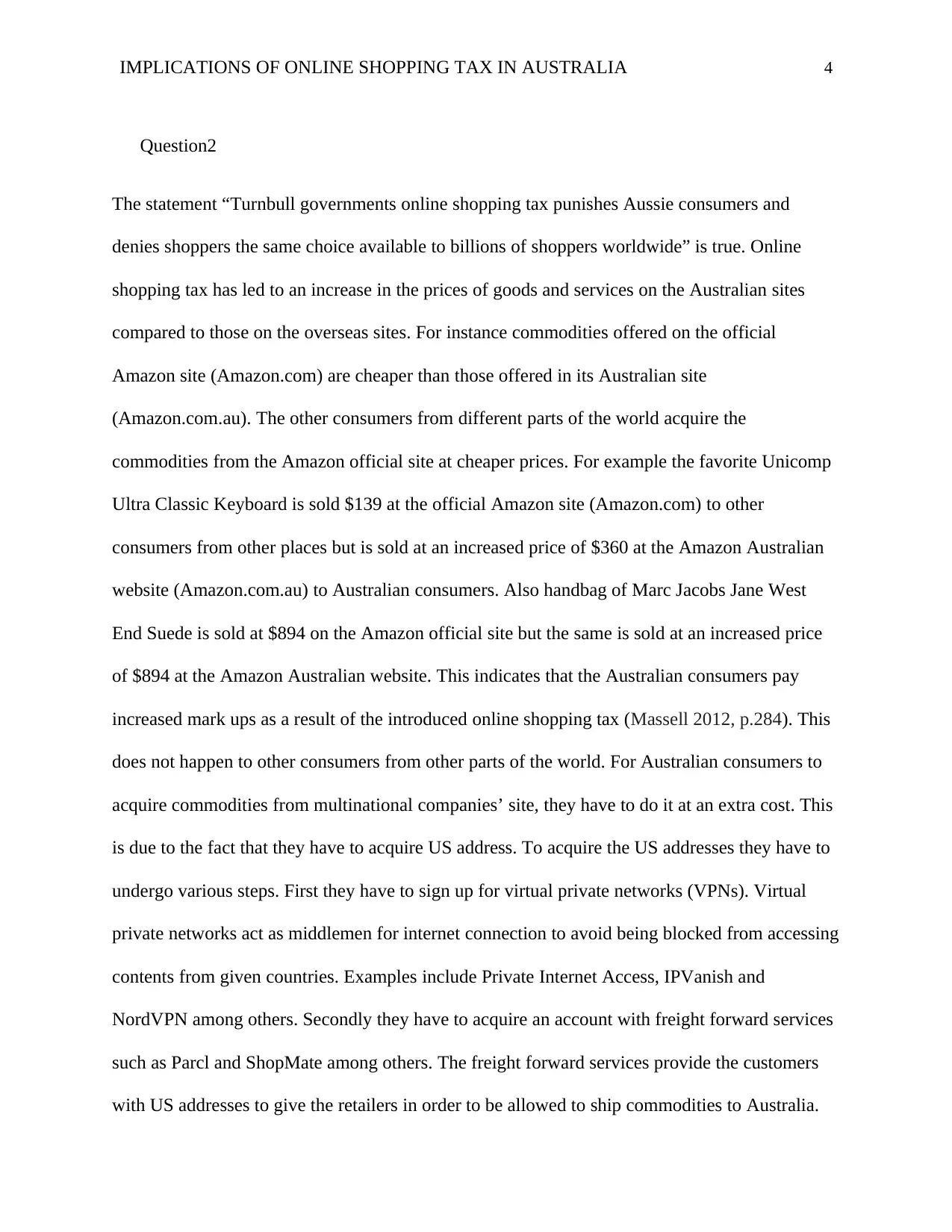
IMPLICATIONS OF ONLINE SHOPPING TAX IN AUSTRALIA 4
Question2
The statement “Turnbull governments online shopping tax punishes Aussie consumers and
denies shoppers the same choice available to billions of shoppers worldwide” is true. Online
shopping tax has led to an increase in the prices of goods and services on the Australian sites
compared to those on the overseas sites. For instance commodities offered on the official
Amazon site (Amazon.com) are cheaper than those offered in its Australian site
(Amazon.com.au). The other consumers from different parts of the world acquire the
commodities from the Amazon official site at cheaper prices. For example the favorite Unicomp
Ultra Classic Keyboard is sold $139 at the official Amazon site (Amazon.com) to other
consumers from other places but is sold at an increased price of $360 at the Amazon Australian
website (Amazon.com.au) to Australian consumers. Also handbag of Marc Jacobs Jane West
End Suede is sold at $894 on the Amazon official site but the same is sold at an increased price
of $894 at the Amazon Australian website. This indicates that the Australian consumers pay
increased mark ups as a result of the introduced online shopping tax (Massell 2012, p.284). This
does not happen to other consumers from other parts of the world. For Australian consumers to
acquire commodities from multinational companies’ site, they have to do it at an extra cost. This
is due to the fact that they have to acquire US address. To acquire the US addresses they have to
undergo various steps. First they have to sign up for virtual private networks (VPNs). Virtual
private networks act as middlemen for internet connection to avoid being blocked from accessing
contents from given countries. Examples include Private Internet Access, IPVanish and
NordVPN among others. Secondly they have to acquire an account with freight forward services
such as Parcl and ShopMate among others. The freight forward services provide the customers
with US addresses to give the retailers in order to be allowed to ship commodities to Australia.
Question2
The statement “Turnbull governments online shopping tax punishes Aussie consumers and
denies shoppers the same choice available to billions of shoppers worldwide” is true. Online
shopping tax has led to an increase in the prices of goods and services on the Australian sites
compared to those on the overseas sites. For instance commodities offered on the official
Amazon site (Amazon.com) are cheaper than those offered in its Australian site
(Amazon.com.au). The other consumers from different parts of the world acquire the
commodities from the Amazon official site at cheaper prices. For example the favorite Unicomp
Ultra Classic Keyboard is sold $139 at the official Amazon site (Amazon.com) to other
consumers from other places but is sold at an increased price of $360 at the Amazon Australian
website (Amazon.com.au) to Australian consumers. Also handbag of Marc Jacobs Jane West
End Suede is sold at $894 on the Amazon official site but the same is sold at an increased price
of $894 at the Amazon Australian website. This indicates that the Australian consumers pay
increased mark ups as a result of the introduced online shopping tax (Massell 2012, p.284). This
does not happen to other consumers from other parts of the world. For Australian consumers to
acquire commodities from multinational companies’ site, they have to do it at an extra cost. This
is due to the fact that they have to acquire US address. To acquire the US addresses they have to
undergo various steps. First they have to sign up for virtual private networks (VPNs). Virtual
private networks act as middlemen for internet connection to avoid being blocked from accessing
contents from given countries. Examples include Private Internet Access, IPVanish and
NordVPN among others. Secondly they have to acquire an account with freight forward services
such as Parcl and ShopMate among others. The freight forward services provide the customers
with US addresses to give the retailers in order to be allowed to ship commodities to Australia.
Paraphrase This Document
Need a fresh take? Get an instant paraphrase of this document with our AI Paraphraser
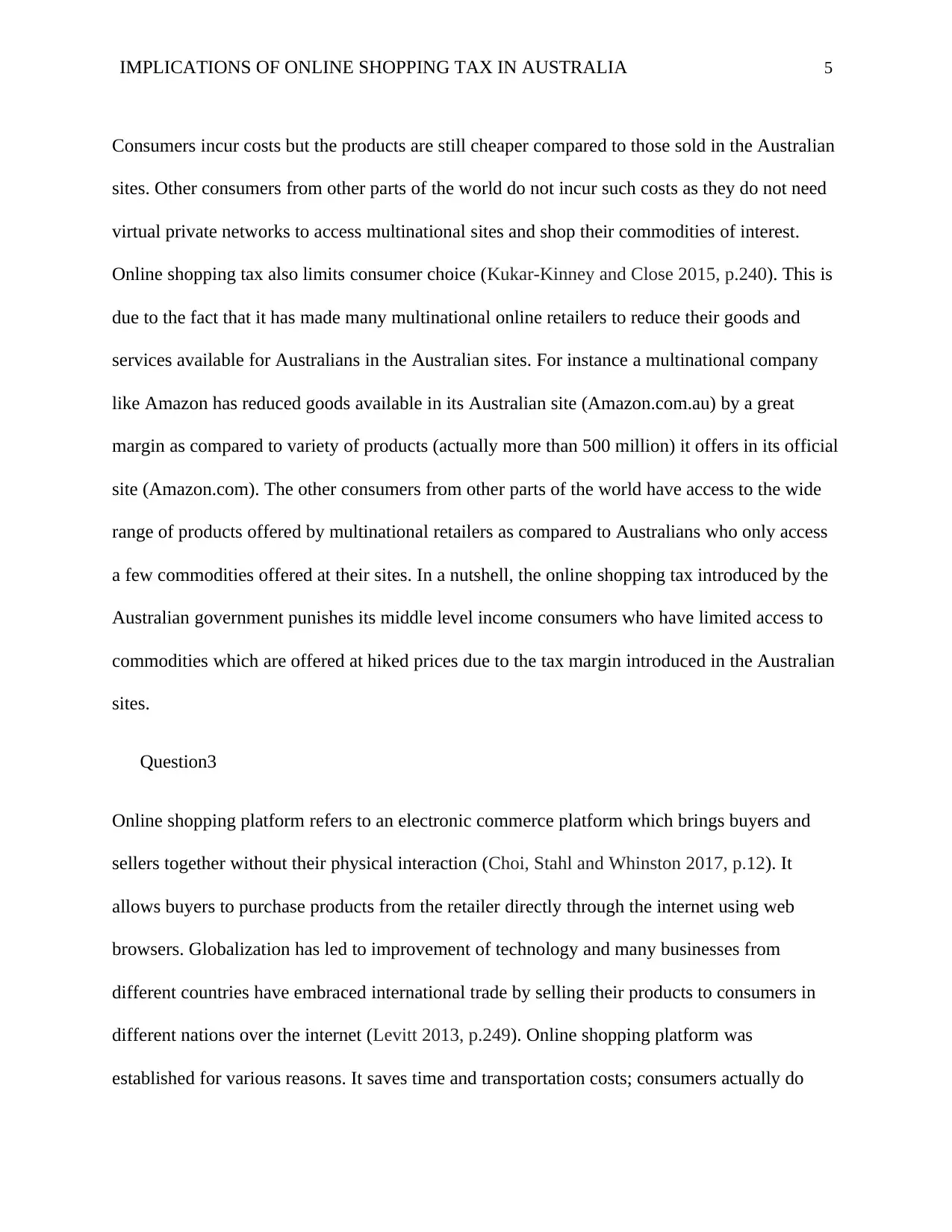
IMPLICATIONS OF ONLINE SHOPPING TAX IN AUSTRALIA 5
Consumers incur costs but the products are still cheaper compared to those sold in the Australian
sites. Other consumers from other parts of the world do not incur such costs as they do not need
virtual private networks to access multinational sites and shop their commodities of interest.
Online shopping tax also limits consumer choice (Kukar-Kinney and Close 2015, p.240). This is
due to the fact that it has made many multinational online retailers to reduce their goods and
services available for Australians in the Australian sites. For instance a multinational company
like Amazon has reduced goods available in its Australian site (Amazon.com.au) by a great
margin as compared to variety of products (actually more than 500 million) it offers in its official
site (Amazon.com). The other consumers from other parts of the world have access to the wide
range of products offered by multinational retailers as compared to Australians who only access
a few commodities offered at their sites. In a nutshell, the online shopping tax introduced by the
Australian government punishes its middle level income consumers who have limited access to
commodities which are offered at hiked prices due to the tax margin introduced in the Australian
sites.
Question3
Online shopping platform refers to an electronic commerce platform which brings buyers and
sellers together without their physical interaction (Choi, Stahl and Whinston 2017, p.12). It
allows buyers to purchase products from the retailer directly through the internet using web
browsers. Globalization has led to improvement of technology and many businesses from
different countries have embraced international trade by selling their products to consumers in
different nations over the internet (Levitt 2013, p.249). Online shopping platform was
established for various reasons. It saves time and transportation costs; consumers actually do
Consumers incur costs but the products are still cheaper compared to those sold in the Australian
sites. Other consumers from other parts of the world do not incur such costs as they do not need
virtual private networks to access multinational sites and shop their commodities of interest.
Online shopping tax also limits consumer choice (Kukar-Kinney and Close 2015, p.240). This is
due to the fact that it has made many multinational online retailers to reduce their goods and
services available for Australians in the Australian sites. For instance a multinational company
like Amazon has reduced goods available in its Australian site (Amazon.com.au) by a great
margin as compared to variety of products (actually more than 500 million) it offers in its official
site (Amazon.com). The other consumers from other parts of the world have access to the wide
range of products offered by multinational retailers as compared to Australians who only access
a few commodities offered at their sites. In a nutshell, the online shopping tax introduced by the
Australian government punishes its middle level income consumers who have limited access to
commodities which are offered at hiked prices due to the tax margin introduced in the Australian
sites.
Question3
Online shopping platform refers to an electronic commerce platform which brings buyers and
sellers together without their physical interaction (Choi, Stahl and Whinston 2017, p.12). It
allows buyers to purchase products from the retailer directly through the internet using web
browsers. Globalization has led to improvement of technology and many businesses from
different countries have embraced international trade by selling their products to consumers in
different nations over the internet (Levitt 2013, p.249). Online shopping platform was
established for various reasons. It saves time and transportation costs; consumers actually do
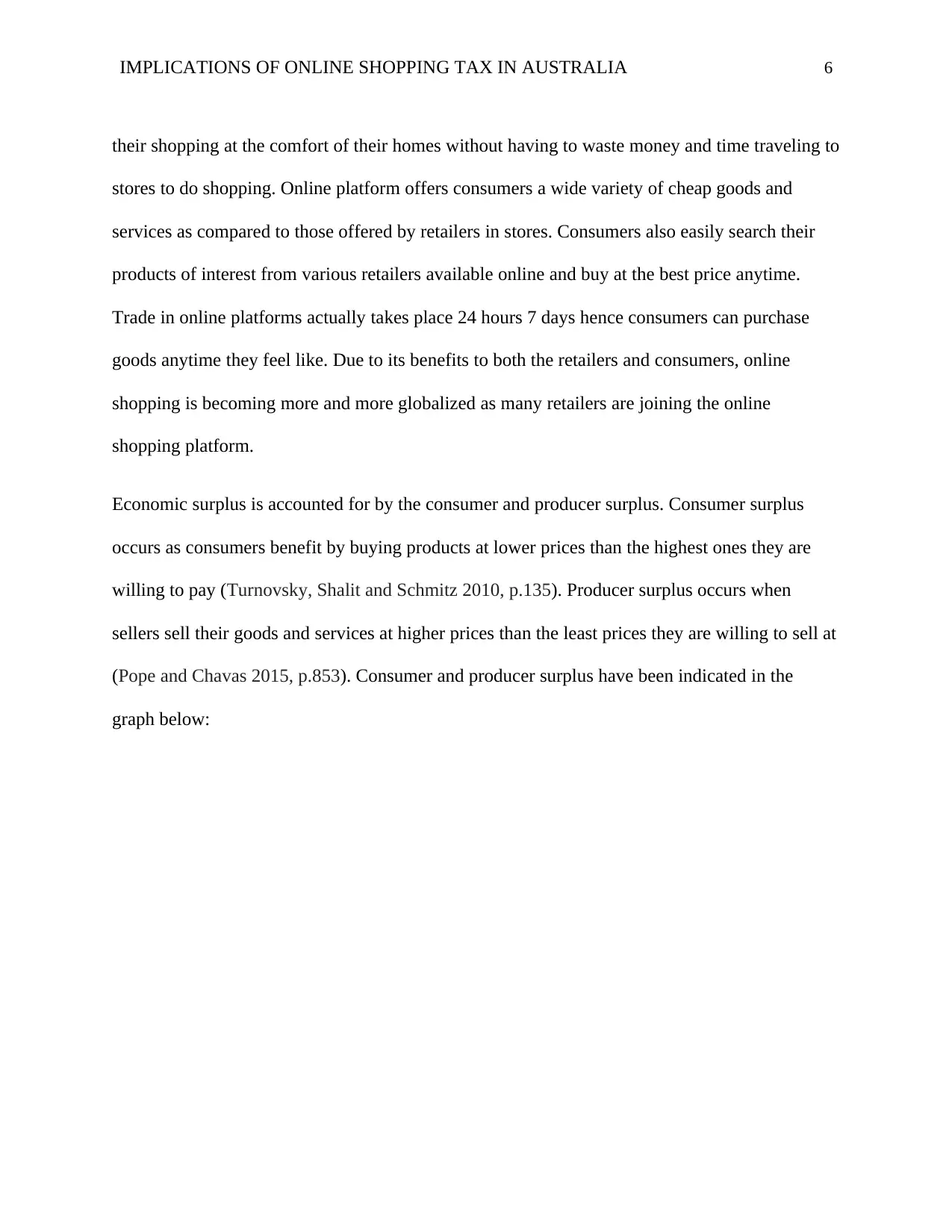
IMPLICATIONS OF ONLINE SHOPPING TAX IN AUSTRALIA 6
their shopping at the comfort of their homes without having to waste money and time traveling to
stores to do shopping. Online platform offers consumers a wide variety of cheap goods and
services as compared to those offered by retailers in stores. Consumers also easily search their
products of interest from various retailers available online and buy at the best price anytime.
Trade in online platforms actually takes place 24 hours 7 days hence consumers can purchase
goods anytime they feel like. Due to its benefits to both the retailers and consumers, online
shopping is becoming more and more globalized as many retailers are joining the online
shopping platform.
Economic surplus is accounted for by the consumer and producer surplus. Consumer surplus
occurs as consumers benefit by buying products at lower prices than the highest ones they are
willing to pay (Turnovsky, Shalit and Schmitz 2010, p.135). Producer surplus occurs when
sellers sell their goods and services at higher prices than the least prices they are willing to sell at
(Pope and Chavas 2015, p.853). Consumer and producer surplus have been indicated in the
graph below:
their shopping at the comfort of their homes without having to waste money and time traveling to
stores to do shopping. Online platform offers consumers a wide variety of cheap goods and
services as compared to those offered by retailers in stores. Consumers also easily search their
products of interest from various retailers available online and buy at the best price anytime.
Trade in online platforms actually takes place 24 hours 7 days hence consumers can purchase
goods anytime they feel like. Due to its benefits to both the retailers and consumers, online
shopping is becoming more and more globalized as many retailers are joining the online
shopping platform.
Economic surplus is accounted for by the consumer and producer surplus. Consumer surplus
occurs as consumers benefit by buying products at lower prices than the highest ones they are
willing to pay (Turnovsky, Shalit and Schmitz 2010, p.135). Producer surplus occurs when
sellers sell their goods and services at higher prices than the least prices they are willing to sell at
(Pope and Chavas 2015, p.853). Consumer and producer surplus have been indicated in the
graph below:
⊘ This is a preview!⊘
Do you want full access?
Subscribe today to unlock all pages.

Trusted by 1+ million students worldwide
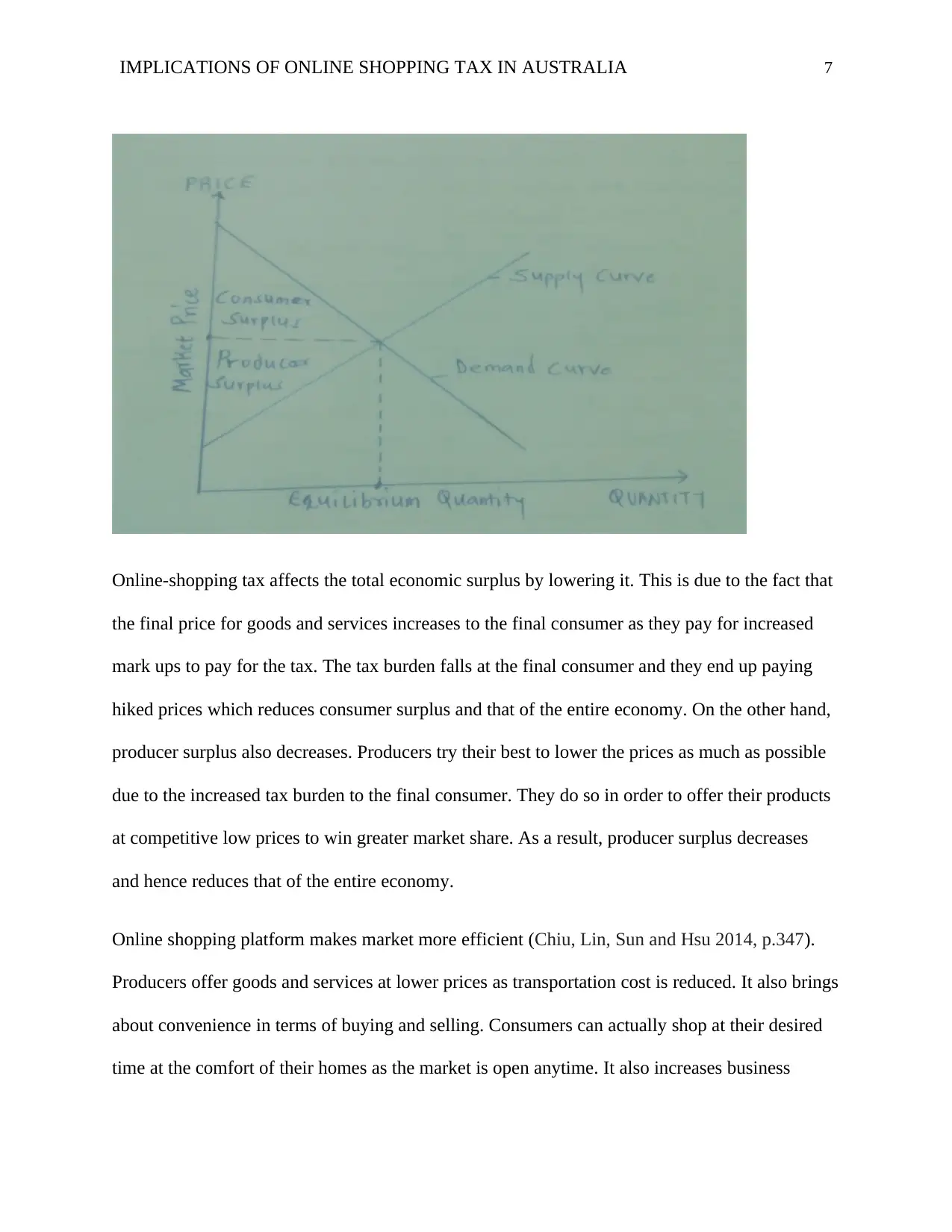
IMPLICATIONS OF ONLINE SHOPPING TAX IN AUSTRALIA 7
Online-shopping tax affects the total economic surplus by lowering it. This is due to the fact that
the final price for goods and services increases to the final consumer as they pay for increased
mark ups to pay for the tax. The tax burden falls at the final consumer and they end up paying
hiked prices which reduces consumer surplus and that of the entire economy. On the other hand,
producer surplus also decreases. Producers try their best to lower the prices as much as possible
due to the increased tax burden to the final consumer. They do so in order to offer their products
at competitive low prices to win greater market share. As a result, producer surplus decreases
and hence reduces that of the entire economy.
Online shopping platform makes market more efficient (Chiu, Lin, Sun and Hsu 2014, p.347).
Producers offer goods and services at lower prices as transportation cost is reduced. It also brings
about convenience in terms of buying and selling. Consumers can actually shop at their desired
time at the comfort of their homes as the market is open anytime. It also increases business
Online-shopping tax affects the total economic surplus by lowering it. This is due to the fact that
the final price for goods and services increases to the final consumer as they pay for increased
mark ups to pay for the tax. The tax burden falls at the final consumer and they end up paying
hiked prices which reduces consumer surplus and that of the entire economy. On the other hand,
producer surplus also decreases. Producers try their best to lower the prices as much as possible
due to the increased tax burden to the final consumer. They do so in order to offer their products
at competitive low prices to win greater market share. As a result, producer surplus decreases
and hence reduces that of the entire economy.
Online shopping platform makes market more efficient (Chiu, Lin, Sun and Hsu 2014, p.347).
Producers offer goods and services at lower prices as transportation cost is reduced. It also brings
about convenience in terms of buying and selling. Consumers can actually shop at their desired
time at the comfort of their homes as the market is open anytime. It also increases business
Paraphrase This Document
Need a fresh take? Get an instant paraphrase of this document with our AI Paraphraser
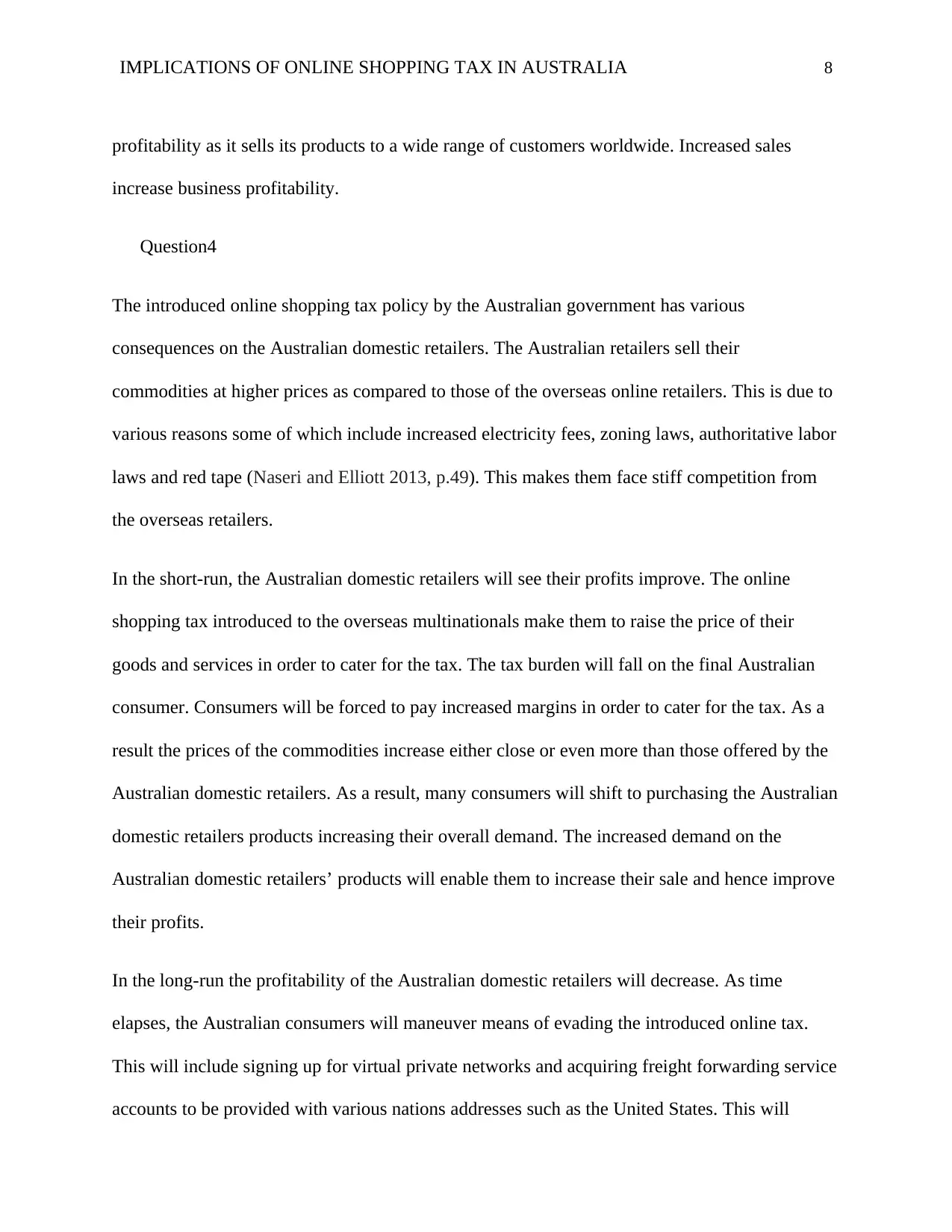
IMPLICATIONS OF ONLINE SHOPPING TAX IN AUSTRALIA 8
profitability as it sells its products to a wide range of customers worldwide. Increased sales
increase business profitability.
Question4
The introduced online shopping tax policy by the Australian government has various
consequences on the Australian domestic retailers. The Australian retailers sell their
commodities at higher prices as compared to those of the overseas online retailers. This is due to
various reasons some of which include increased electricity fees, zoning laws, authoritative labor
laws and red tape (Naseri and Elliott 2013, p.49). This makes them face stiff competition from
the overseas retailers.
In the short-run, the Australian domestic retailers will see their profits improve. The online
shopping tax introduced to the overseas multinationals make them to raise the price of their
goods and services in order to cater for the tax. The tax burden will fall on the final Australian
consumer. Consumers will be forced to pay increased margins in order to cater for the tax. As a
result the prices of the commodities increase either close or even more than those offered by the
Australian domestic retailers. As a result, many consumers will shift to purchasing the Australian
domestic retailers products increasing their overall demand. The increased demand on the
Australian domestic retailers’ products will enable them to increase their sale and hence improve
their profits.
In the long-run the profitability of the Australian domestic retailers will decrease. As time
elapses, the Australian consumers will maneuver means of evading the introduced online tax.
This will include signing up for virtual private networks and acquiring freight forwarding service
accounts to be provided with various nations addresses such as the United States. This will
profitability as it sells its products to a wide range of customers worldwide. Increased sales
increase business profitability.
Question4
The introduced online shopping tax policy by the Australian government has various
consequences on the Australian domestic retailers. The Australian retailers sell their
commodities at higher prices as compared to those of the overseas online retailers. This is due to
various reasons some of which include increased electricity fees, zoning laws, authoritative labor
laws and red tape (Naseri and Elliott 2013, p.49). This makes them face stiff competition from
the overseas retailers.
In the short-run, the Australian domestic retailers will see their profits improve. The online
shopping tax introduced to the overseas multinationals make them to raise the price of their
goods and services in order to cater for the tax. The tax burden will fall on the final Australian
consumer. Consumers will be forced to pay increased margins in order to cater for the tax. As a
result the prices of the commodities increase either close or even more than those offered by the
Australian domestic retailers. As a result, many consumers will shift to purchasing the Australian
domestic retailers products increasing their overall demand. The increased demand on the
Australian domestic retailers’ products will enable them to increase their sale and hence improve
their profits.
In the long-run the profitability of the Australian domestic retailers will decrease. As time
elapses, the Australian consumers will maneuver means of evading the introduced online tax.
This will include signing up for virtual private networks and acquiring freight forwarding service
accounts to be provided with various nations addresses such as the United States. This will
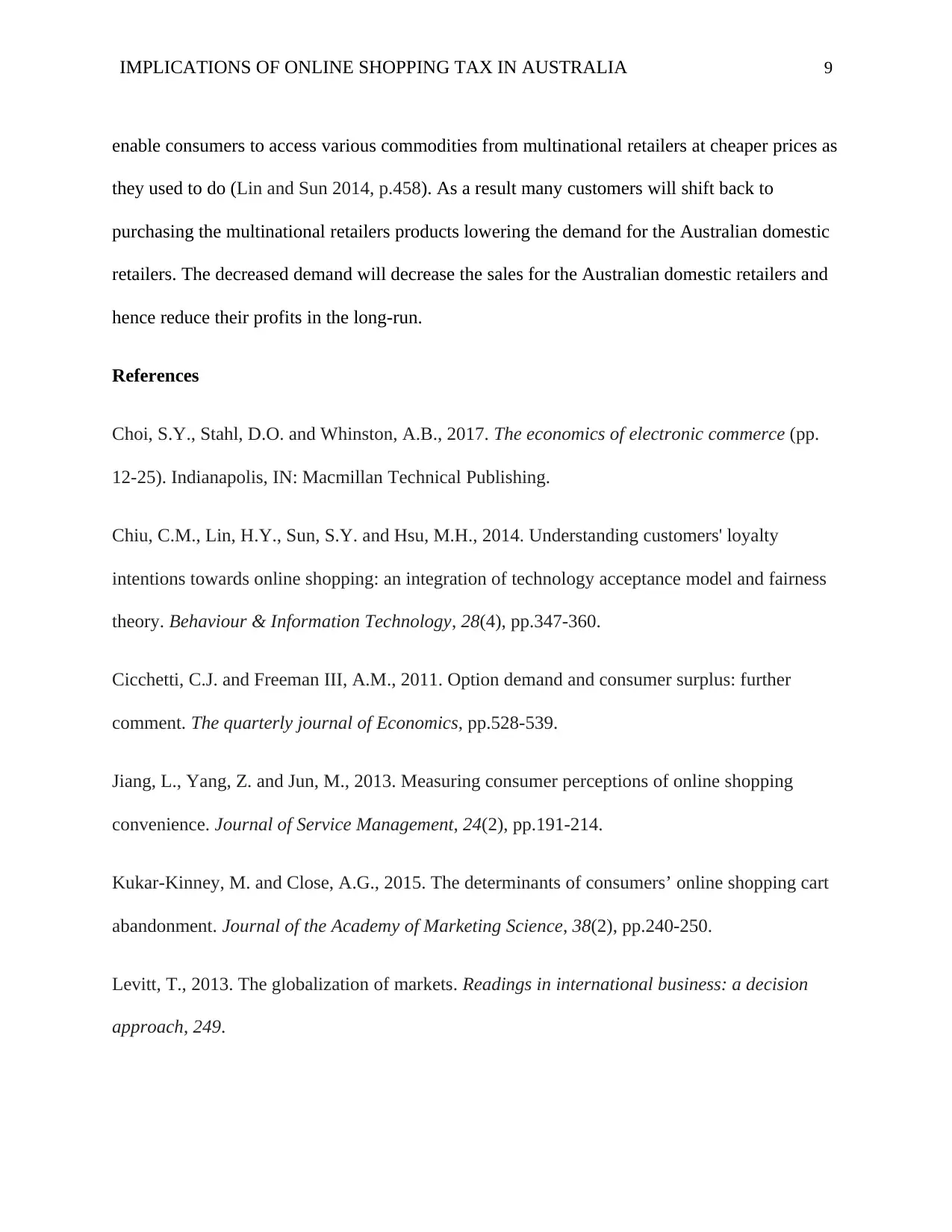
IMPLICATIONS OF ONLINE SHOPPING TAX IN AUSTRALIA 9
enable consumers to access various commodities from multinational retailers at cheaper prices as
they used to do (Lin and Sun 2014, p.458). As a result many customers will shift back to
purchasing the multinational retailers products lowering the demand for the Australian domestic
retailers. The decreased demand will decrease the sales for the Australian domestic retailers and
hence reduce their profits in the long-run.
References
Choi, S.Y., Stahl, D.O. and Whinston, A.B., 2017. The economics of electronic commerce (pp.
12-25). Indianapolis, IN: Macmillan Technical Publishing.
Chiu, C.M., Lin, H.Y., Sun, S.Y. and Hsu, M.H., 2014. Understanding customers' loyalty
intentions towards online shopping: an integration of technology acceptance model and fairness
theory. Behaviour & Information Technology, 28(4), pp.347-360.
Cicchetti, C.J. and Freeman III, A.M., 2011. Option demand and consumer surplus: further
comment. The quarterly journal of Economics, pp.528-539.
Jiang, L., Yang, Z. and Jun, M., 2013. Measuring consumer perceptions of online shopping
convenience. Journal of Service Management, 24(2), pp.191-214.
Kukar-Kinney, M. and Close, A.G., 2015. The determinants of consumers’ online shopping cart
abandonment. Journal of the Academy of Marketing Science, 38(2), pp.240-250.
Levitt, T., 2013. The globalization of markets. Readings in international business: a decision
approach, 249.
enable consumers to access various commodities from multinational retailers at cheaper prices as
they used to do (Lin and Sun 2014, p.458). As a result many customers will shift back to
purchasing the multinational retailers products lowering the demand for the Australian domestic
retailers. The decreased demand will decrease the sales for the Australian domestic retailers and
hence reduce their profits in the long-run.
References
Choi, S.Y., Stahl, D.O. and Whinston, A.B., 2017. The economics of electronic commerce (pp.
12-25). Indianapolis, IN: Macmillan Technical Publishing.
Chiu, C.M., Lin, H.Y., Sun, S.Y. and Hsu, M.H., 2014. Understanding customers' loyalty
intentions towards online shopping: an integration of technology acceptance model and fairness
theory. Behaviour & Information Technology, 28(4), pp.347-360.
Cicchetti, C.J. and Freeman III, A.M., 2011. Option demand and consumer surplus: further
comment. The quarterly journal of Economics, pp.528-539.
Jiang, L., Yang, Z. and Jun, M., 2013. Measuring consumer perceptions of online shopping
convenience. Journal of Service Management, 24(2), pp.191-214.
Kukar-Kinney, M. and Close, A.G., 2015. The determinants of consumers’ online shopping cart
abandonment. Journal of the Academy of Marketing Science, 38(2), pp.240-250.
Levitt, T., 2013. The globalization of markets. Readings in international business: a decision
approach, 249.
⊘ This is a preview!⊘
Do you want full access?
Subscribe today to unlock all pages.

Trusted by 1+ million students worldwide
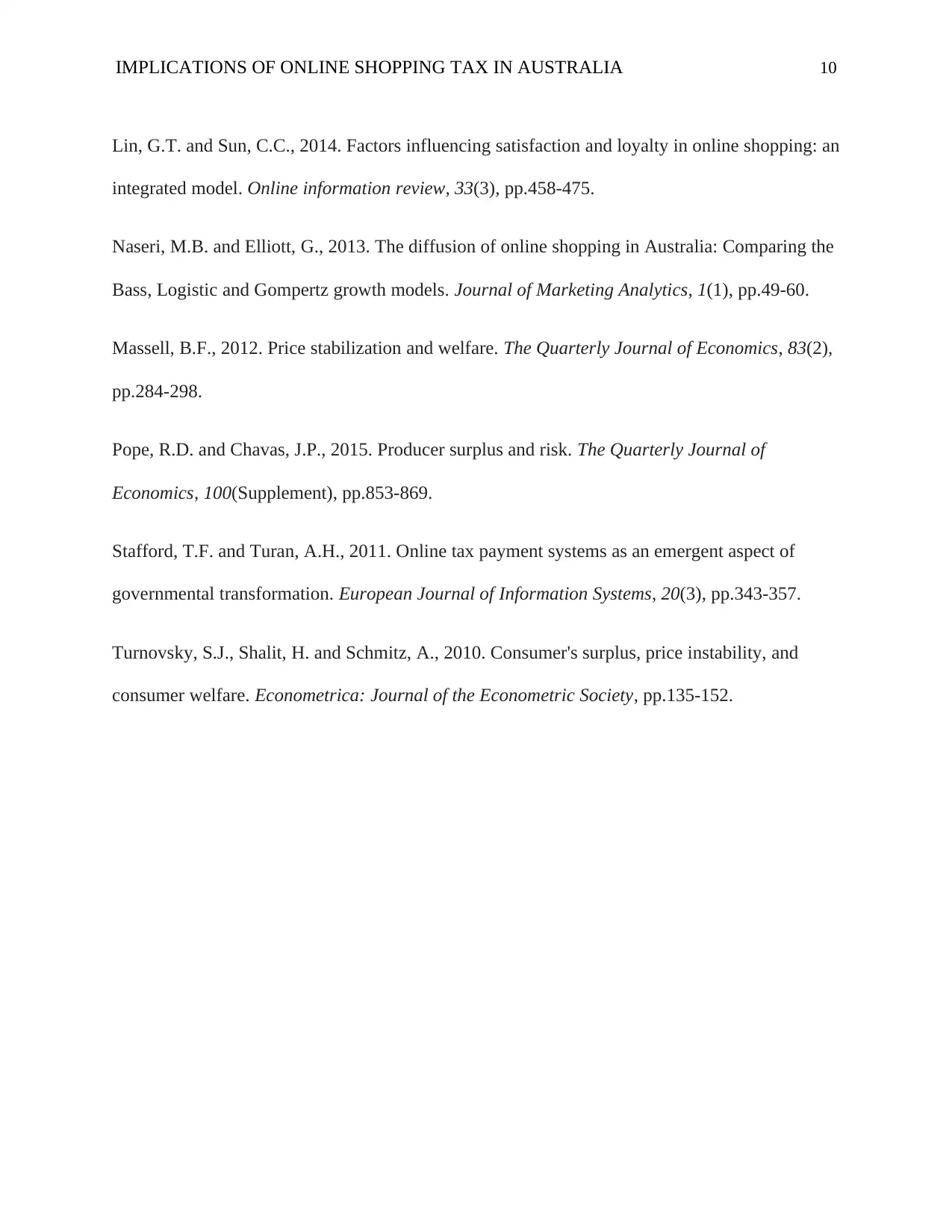
IMPLICATIONS OF ONLINE SHOPPING TAX IN AUSTRALIA 10
Lin, G.T. and Sun, C.C., 2014. Factors influencing satisfaction and loyalty in online shopping: an
integrated model. Online information review, 33(3), pp.458-475.
Naseri, M.B. and Elliott, G., 2013. The diffusion of online shopping in Australia: Comparing the
Bass, Logistic and Gompertz growth models. Journal of Marketing Analytics, 1(1), pp.49-60.
Massell, B.F., 2012. Price stabilization and welfare. The Quarterly Journal of Economics, 83(2),
pp.284-298.
Pope, R.D. and Chavas, J.P., 2015. Producer surplus and risk. The Quarterly Journal of
Economics, 100(Supplement), pp.853-869.
Stafford, T.F. and Turan, A.H., 2011. Online tax payment systems as an emergent aspect of
governmental transformation. European Journal of Information Systems, 20(3), pp.343-357.
Turnovsky, S.J., Shalit, H. and Schmitz, A., 2010. Consumer's surplus, price instability, and
consumer welfare. Econometrica: Journal of the Econometric Society, pp.135-152.
Lin, G.T. and Sun, C.C., 2014. Factors influencing satisfaction and loyalty in online shopping: an
integrated model. Online information review, 33(3), pp.458-475.
Naseri, M.B. and Elliott, G., 2013. The diffusion of online shopping in Australia: Comparing the
Bass, Logistic and Gompertz growth models. Journal of Marketing Analytics, 1(1), pp.49-60.
Massell, B.F., 2012. Price stabilization and welfare. The Quarterly Journal of Economics, 83(2),
pp.284-298.
Pope, R.D. and Chavas, J.P., 2015. Producer surplus and risk. The Quarterly Journal of
Economics, 100(Supplement), pp.853-869.
Stafford, T.F. and Turan, A.H., 2011. Online tax payment systems as an emergent aspect of
governmental transformation. European Journal of Information Systems, 20(3), pp.343-357.
Turnovsky, S.J., Shalit, H. and Schmitz, A., 2010. Consumer's surplus, price instability, and
consumer welfare. Econometrica: Journal of the Econometric Society, pp.135-152.
1 out of 10
Related Documents
Your All-in-One AI-Powered Toolkit for Academic Success.
+13062052269
info@desklib.com
Available 24*7 on WhatsApp / Email
![[object Object]](/_next/static/media/star-bottom.7253800d.svg)
Unlock your academic potential
Copyright © 2020–2025 A2Z Services. All Rights Reserved. Developed and managed by ZUCOL.



